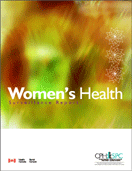

  |
|||||||||||||||||

|
[Previous] [Table of Contents] [Next] Multiple Roles and Women's Mental Health in CanadaHeather Maclean, EdD; Keva Glynn, MHSc; and Donna Ansara, MSc, PhD candidate (Centre for Research in Women's Health) Health IssueThis chapter extends previous analyses on the moderating effects of different role combinations on women's mental health and situates this analysis in a social context. The relation between socio-economic factors and women's mental health is assessed with respect to different combinations of women's roles: (i) single mothers, employed and non-employed; (ii) partnered mothers, employed and non-employed; (iii) women without children, partnered and single; and (iv) women without children, employed and non-employed. A new analysis using National Population Health Survey data from 1994-1995 and 1998-1999 examines the association between different role combinations and socio-economic status, and the differences in women's stress, distress, and chronic stress levels according to the various combinations of roles. Key Findings
The results clearly show that the distress, stress, and chronic stress levels of mothers, regardless of employment or marital status, are high, particularly for single, non-employed mothers. The inclusion of life context (chronic stress) in the assessment of personal stress results in higher reports of stress for all four groups. The apparent negative influence of the wider social context on women's mental health speaks to the need for further investigation into the social and environmental conditions influencing women's experiences with multiple roles. In particular, given the disturbing results with respect to the mental health of single, non-employed mothers, further attention needs to be paid to the legislative, social, and environmental factors contributing to their poor state of mental health. Data Gaps and RecommendationsData CollectionThe authors identified the following data gaps:
Policy RecommendationsThe authors made the following recommendations:
Download Full Chapter (PDF)[Previous] [Table of Contents] [Next] |
| Last Updated: 2003-12-09 | |||